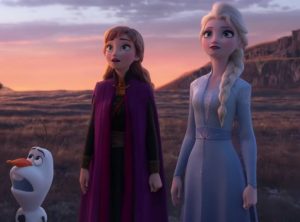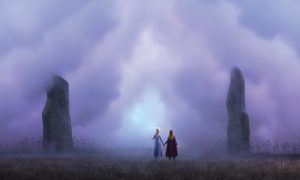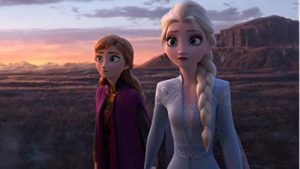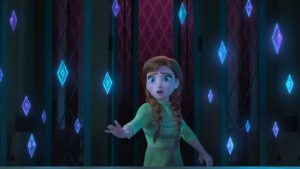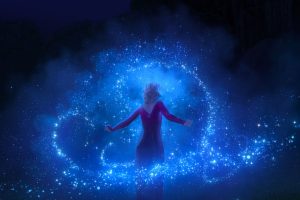SPOILERS FOR FROZEN 2 AHEAD!
There’s a lot of movie to talk about in this post. Frozen 2 is completely different from its predecessor, which avoided controversy by sticking to more traditional Disney fare: true love, family bonds, embracing your differences, etc, etc. Frozen 2 takes risks by leaping into the thick of some of the most heated discussions of this century – there’s commentary on generational divides, nationalism, and environmentalism, among other things. And since this is a spoiler review, we can talk about all of it.
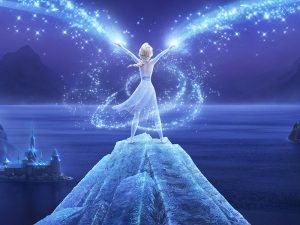
While the subject of nationalism would seem the most foreign and shocking in a family-friendly Disney movie about two princesses and a lovable snowman, it was actually the topic that I most strongly suspected Frozen 2 would touch on, in some way or another. Back in September, I speculated that Elsa and Anna’s peaceful city-state of Arendelle had some dark secrets they wanted to keep hidden: namely, their persecution of the Northuldra peoples. This persecution has its roots in the very real, very tragic story of the nomadic Sámi peoples of northern Scandinavia whose culture and history was almost wiped off the face of the planet by the governments under whose “protection” they dwelt. Mostly, the governments of Norway and Sweden – the two countries whose cultures have informed the creation of the peaceful sea-port of Arendelle, with its majestic fjord and majority-white population. The Northuldra tribe in Frozen 2, on the other hand, are very clearly stand-ins for the Sámi – to the point where the film even hired Sámi consultants. I guessed at once that Elsa and Anna might be in for a nasty surprise if and when they discovered that their country had actively worked to massacre an entire race of people.
But while I had worked out the basic framework of the story, I was unable to guess how important the Norway vs Sámi/Arendelle vs Northuldra conflict would be to the entire plot of Frozen 2. And that’s where the parallels to 1995’s Pocahontas, a film I referenced in my non-spoiler review as an unlikely contrast to this one, come in.
Both films deal with the interactions between a majority-white nation and a peaceful indigenous people. But while the early flashbacks in Frozen 2 indicate that relations between the two peoples were just that, peaceful, it turns out later in the movie that those flashbacks lied to us – or was it just that Elsa and Anna’s father, King Agnarr, was an unreliable narrator, leaving out the bits where his people turned on their friends and tried to kill them all? Yes, Elsa (Idina Menzel) discovers in the third act that her revered grandfather, King Runeard of Arendelle (Jeremy Sisto), attempted to wipe out the Northuldra by building a huge dam across the fjord which threatened their way of life – why, you ask? Well, the film does somewhat gloss over the notion of racial prejudice, but does touch on a form of bigotry – if not one we’re accustomed to seeing in the real world: Runeard’s fear and hatred of people who use magic (such as the Northuldra). Runeard’s plan to subtly undermine the Northuldra with his dam goes awry when the leader of the Northuldra sees through his deception and tries to stop him, leading to open conflict between the two peoples, one in which Runeard and the Northuldra leader were both killed by falling over a cliff.
Elsa never actually meets him personally, but she does have a brief encounter with…well, it’s not exactly his ghost, but I don’t know what to call it: ice-sculpture moving photograph? Confronting him over his fears and prejudices, Elsa wonders out loud what her grandfather would think of her, a brave young woman who controls all of the four elements of magic, in one of the most powerful moments in the movie. Unfortunately, Runeard is kind of dead, so it’s hard for Elsa to have any sort of meaningful interactions with him – but she doesn’t have to, because as I said in my non-spoiler review, Frozen 2 isn’t about clinging to the past, it’s about moving forward into the future. Runeard, the film’s only real villain, represents an older, more backwards-thinking generation who prevent change and progress: Elsa and Anna, representing millennials, are the change and progress, and they have better things to do with their time than get into arguments with the ghosts of bitter old racists. And so both Anna and Elsa turn away from the crimes and dark secrets buried in their family’s past and walk into the future hand-in-hand, helping to right Arendelle’s wrongs by destroying Runeard’s dam (even if it does nearly leave Arendelle drowned under a whole new fjord in what I can only describe as the Fords of Bruinen scene from The Lord Of The Rings multiplied tenfold), breaking the magical enchantments that separate Northuldran territory from Arendelle, and commissioning memorials to the Northuldra people. By acknowledging the crimes that white colonizers did to the indigenous peoples of Scandinavia, Frozen 2 is already a step ahead of Pocahontas, which blithely pretended that after Governor Ratcliffe was locked up in chains, everything was fine and dandy in the New World. By setting the story long after the violence occurred, Frozen 2 allows its young protagonists to learn the mistakes that their ancestors made, and do their part to try and fix them, since it’s too late to avert them – that’s a story that many young people can relate to, as they too inherit a world damaged by the actions of previous generations, what with wars, climate change, etc, etc.
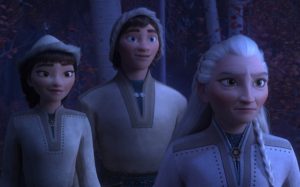
The film also, somewhat more controversially, gives Anna (Kristen Bell) and Elsa a personal stake in the fight by revealing that they are…bear with me here…mixed-race. Their mother, Iduna (Evan Rachel Wood), was actually a Northuldran woman who danced with flying leaves in the wind before rescuing a handsome young blond man from certain death, falling in love with him and returning with him to his kingdom…hold on a moment, this movie really is mirroring Pocahontas. Anna and Elsa are still very much white, however, and that fact actually shouldn’t be a problem, since many of the Sámi peoples of Scandinavia are, in fact, white. However, Frozen 2 takes the liberty of interpreting the Northuldra as darker-skinned, with dark hair – probably in an attempt to make the diversity look more clearly diverse. In the end it somewhat backfires by making Anna and Elsa into the sole white women among a group of people of color, coming in to save the day and free them from their captivity in the forest…in other words, they get a bit of the white savior treatment, and it’s not a good look for either character, or for Disney.

In the end, though, Elsa actually goes to live with the Northuldra, feeling her true calling among her mother’s people. Having discovered at the end of the movie that she is the “fifth spirit” who can control the four elements of fire, water, earth and wind, Elsa has become a shimmering goddess of the tundra, resplendent in an Aurora Borealis-inspired gown, riding a water-horse and carrying a fiery salamander as her animal sidekick. And, um, yeah, the movie never really does anything to explain why she got stuck with ice powers specifically. Instead, it spends a lot of time focusing on Elsa’s environmentalist journey: abandoning the trappings of modern (okay, well, late 19th Century modern) civilization, Elsa goes back to nature and finds peace there, among the splendor of the Norwegian wilderness. Whether or not she learns to paint with all the colors of the wind, we won’t know until Frozen 3.
Speaking of Frozen 3, it’s time to talk sequels. The film actually leaves off rather conclusively – Elsa is living her best life in the far north as a magic guru goddess, Anna is the progressive new queen of Arendelle, we’ve learned pretty much everything there is to know about Elsa’s magic (I think), and there’s peace at last in fantasy Norway. But is that peace destined to last? Looking at the progression in Elsa and Anna’s stories over the last two films, a pattern emerges: in the first film, we saw them brought together by the power of true love, risking their lives to save each other; in the second film, their journey takes the two sisters in different directions, leading them to finally separate and lead separate lives. What’s left for a third film to explore? Frozen: Civil War, in which Team Anna and Team Elsa face off against each other in the most brutal snowball-fight ever animated? Well, I don’t expect it to get that extreme (though I wouldn’t complain if it did), but something along those lines wouldn’t be a bad idea. We’ve seen them together, we’ve seen them separate – now would be a good time to show them on opposite sides of a conflict, eventually realizing they have to work together once more to solve a problem. As for what that problem could be: well, I’d recommend an actual villain. Runeard’s legacy of evil worked for Frozen 2 because of the message it was trying to send, but a third film would be a great place for an actual enemy to arise and threaten fantasy Norway. There might even be some opportunities to play with the concept of Dark Elsa – after all, she was originally written to be the first film’s villain.
Some things I wouldn’t expect to see from the third film would be any more revelations about the sisters’ past – Elsa and Anna literally found out everything we could possibly care to know about the history of Arendelle. We even discovered exactly what happened to their parents, the good King Agnarr and Queen Iduna, when the sisters found their wrecked ship washed up onshore. Thanks to Elsa’s magic, the sisters were able to see exactly how their parents perished – turns out, they were on their way to the far north to try and find answers about what Elsa was when they ran into a storm and drowned, holding each other one last time as the waves swallowed them up. So any mystery about them and their fate has been conclusively laid to rest, in the saddest possible way (in case you’re wondering, this scene is one of the three I referenced in my non-spoiler review as being absolutely soul-crushing: the others being Olaf’s temporary death and Elsa’s aforementioned confrontation with her grandfather).
On the bright side, most of the characters get happy-ever-after endings in Frozen 2: Kristoff (Jonathan Groff) finally proposes to Anna and she accepts; Olaf (Josh Gad) is dead, but then he isn’t (something I also predicted back in September); Elsa maybe-sort-of-kinda-subtly has a thing going on with fellow Northuldran woman Honeymaren (Rachel Matthews), though Disney being Disney, it’ll probably only ever be in subtext, despite how fervently the internet clamors for Elsa to get a girlfriend; Sven gets a whole bunch of new reindeer friends, and presumably isn’t excluded from all their reindeer games. Frozen 2 is darker than this franchise has ever been, and it could be the darkest it’ll ever get – but then again, maybe in six more years we’ll be treated to a third and final installment of the story of the two sisters. At which point in the timeline Kristoff and Anna will probably be parents, Olaf will be older, and Sven will be…well, Sven should be dead at this point considering the average lifespan of a reindeer, but somehow I don’t expect Disney to go in that direction unless they’re feeling particularly dark.
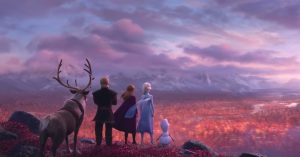
How would you feel about the possibility of Frozen 3, and what would you like to see Anna and Elsa do next? What was your favorite Frozen 2 moment? Share your thoughts, theories and opinions in the comments below!
